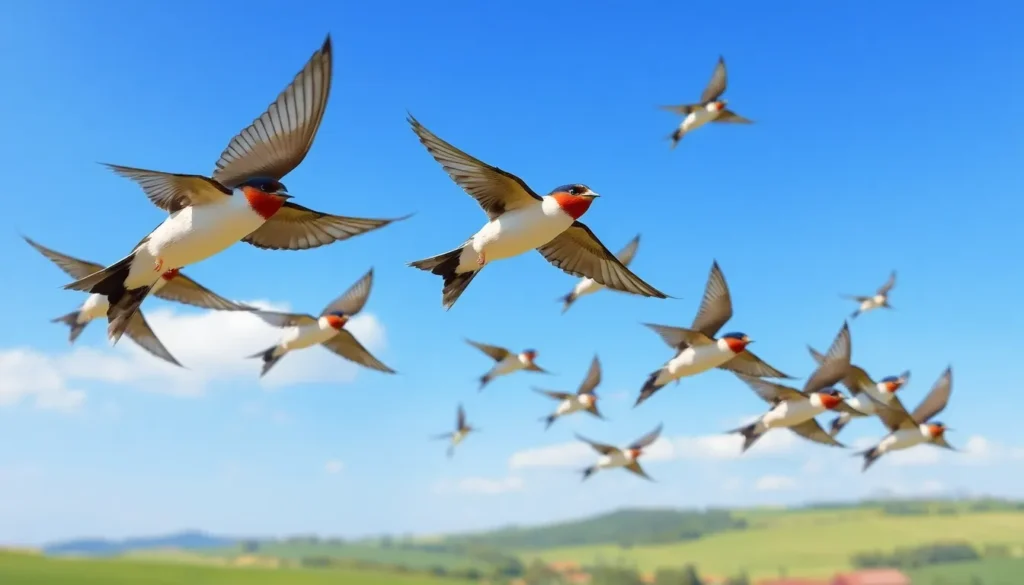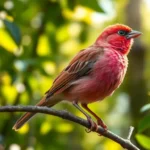We’ve all watched these graceful aerial acrobats slice through the sky with effortless precision, but swallows represent far more than just another backyard bird sighting. These remarkable creatures embark on some of nature’s most incredible journeys, traveling thousands of miles between continents while performing feats of navigation that continue to baffle scientists.
From their distinctive forked tails to their unmatched flying abilities, swallows have captured our imagination for centuries. We’ll explore the intriguing area of these migratory marvels and discover why they’re considered among nature’s most skilled aviators.
Whether you’re spotting barn swallows building mud nests under your eaves or witnessing massive flocks preparing for their epic migrations, understanding these birds transforms ordinary observations into extraordinary wildlife encounters. Join us as we jump into the captivating life of swallows and uncover the secrets behind their remarkable adaptations.
What Is a Swallow Bird
Swallows represent a diverse family of passerine birds known scientifically as Hirundinidae, comprising over 90 species worldwide. These remarkable aerial specialists possess distinctive physical features that make them instantly recognizable to bird enthusiasts and casual observers alike.
Physical Characteristics:
- Streamlined bodies measuring 4-9 inches in length
- Forked tails ranging from slightly notched to deeply divided
- Long, pointed wings spanning 12-17 inches
- Wide, flattened beaks designed for catching insects mid-flight
- Short legs adapted for perching rather than walking
Swallow birds exhibit exceptional flying capabilities that set them apart from other songbirds. Their flight patterns include sharp turns, sudden dives, and prolonged gliding sequences that demonstrate their mastery of aerial navigation. Most species display iridescent blue, green, or purple coloring on their backs and wings, while their undersides typically feature white, cream, or rusty-orange plumage.
These insectivorous birds consume massive quantities of flying insects daily, with individual swallows eating up to 850 insects per day during peak feeding seasons. Common prey includes flies, mosquitoes, flying ants, beetles, and moths that they capture using their wide-opening beaks while maintaining flight speeds of 35-60 mph.
Swallow species inhabit every continent except Antarctica, adapting to diverse environments from urban areas to rural farmlands, wetlands, and coastal regions. Their global distribution includes familiar North American species like the Barn Swallow, Tree Swallow, and Cliff Swallow, each occupying exact ecological niches within their respective ranges.
Physical Characteristics of Swallow Birds

Swallow birds possess remarkable physical adaptations that make them some of the most efficient aerial hunters in the avian industry. We can identify these distinctive birds by their streamlined bodies and specialized flight features that distinguish them from other passerine species.
Size and Body Structure
Most swallow species measure between 4 to 8 inches in length with wingspans ranging from 10 to 17 inches. We observe that Barn Swallows typically reach 6.7 inches in body length while weighing only 0.6 to 0.7 ounces. Tree Swallows measure slightly smaller at 4.7 to 5.9 inches with weights between 0.7 to 0.9 ounces.
Their bodies feature torpedo-shaped profiles that minimize air resistance during flight. We notice their compact torsos connect to proportionally long wings that extend well beyond their tail tips when folded. Short legs with small feet reflect their aerial lifestyle since swallows spend minimal time walking on surfaces.
The skull structure accommodates wide gape measurements that allow efficient insect capture. We find their neck muscles particularly well-developed to support rapid head movements during hunting maneuvers.
Distinctive Features and Coloration
Swallow birds exhibit deeply forked tails that serve as primary identification markers across most species. We recognize these tail formations as critical flight control mechanisms that enable precise aerial navigation and sharp directional changes.
Their wings display long pointed shapes with primary feathers extending significantly beyond secondary feathers. Wing aspect ratios typically measure between 7:1 to 9:1 length-to-width proportions that optimize lift generation and maneuverability.
Coloration patterns vary dramatically among swallow species but commonly feature metallic blue or green upperparts with contrasting lighter underparts. We observe that Barn Swallows showcase deep blue backs with rusty orange throats and buff-colored bellies. Cliff Swallows display darker blue-black upperparts with distinctive white foreheads and rusty rumps.
Many species feature iridescent plumage that appears to shift colors under different lighting conditions. We note sexual dimorphism in several species where males exhibit more vibrant coloration and longer tail streamers than females during breeding seasons.
Their beaks remain short and wide with large gape openings that create funnel-like catching mechanisms. We measure typical beak widths at approximately 0.5 inches across when fully opened during insect capture sequences.
Different Types of Swallow Species

Swallow species display remarkable diversity across their global range, with each type adapted to exact environments and feeding strategies. Understanding these distinct species helps us appreciate the evolutionary success of the Hirundinidae family.
Barn Swallows
Barn Swallows (Hirundo rustica) represent the most widespread swallow species globally, inhabiting every continent except Antarctica and Australia. These birds measure 6 to 7 inches in length with wingspans reaching 12 to 13 inches. Their distinctive features include deeply forked tails with elongated outer feathers, glossy blue-black upperparts, and rusty orange underparts extending to the throat and forehead.
Barn Swallows construct cup-shaped mud nests on human-made structures like barns, bridges, and eaves. Agricultural areas provide optimal hunting grounds where these birds capture flying insects including flies, mosquitoes, beetles, and moths. During migration, Barn Swallows travel distances exceeding 6,000 miles between North American breeding grounds and South American wintering territories.
Breeding pairs produce 2 to 3 broods annually, with each clutch containing 3 to 5 eggs. Males perform elaborate courtship displays featuring aerial acrobatics and tail spreading to attract females. These swallows demonstrate remarkable site fidelity, often returning to the same nesting locations year after year.
Tree Swallows
Tree Swallows (Tachycineta bicolor) inhabit open areas near water bodies across North America, measuring 5 to 6 inches in length with wingspans of 11 to 12 inches. Adult males display iridescent blue-green upperparts contrasting with bright white underparts, while females and juveniles show duller coloration with brownish tones.
These cavity-nesting birds use natural tree holes, old woodpecker excavations, and artificial nest boxes for breeding. Tree Swallows consume aerial insects during warm months but uniquely supplement their diet with berries and seeds during cold periods. This dietary flexibility allows earlier spring arrival and later fall departure compared to other swallow species.
Tree Swallows form massive communal roosts during migration, with gatherings sometimes exceeding 100,000 individuals. Breeding territories center around suitable nesting cavities, with males defending sites through aggressive displays and physical confrontations. Females lay 4 to 7 white eggs, incubating them for 13 to 16 days before hatching.
Cliff Swallows
Cliff Swallows (Petrochelidon pyrrhonota) construct distinctive gourd-shaped mud nests in large colonial aggregations on vertical surfaces. These birds measure 5 to 6 inches in length with square-cut tails distinguishing them from their fork-tailed relatives. Their coloration features dark blue upperparts, white foreheads, rusty throats, and buff-colored rumps creating a distinctive pattern.
Colonial nesting represents the primary behavioral characteristic of Cliff Swallows, with colonies ranging from dozens to thousands of nests clustered together. Natural cliff faces, bridge undersides, and building overhangs provide suitable nesting substrates. These birds demonstrate complex social behaviors including cooperative nest building and communal defense against predators.
Cliff Swallows migrate in large flocks between North American breeding grounds and South American wintering areas, traveling approximately 6,000 miles each way. Their diet consists primarily of flying ants, beetles, flies, and other aerial insects captured during extended foraging flights. Breeding colonies often relocate annually, with site selection influenced by parasite loads and nest success rates from previous seasons.
Habitat and Geographic Distribution

Swallow birds occupy diverse habitats across nearly every continent on Earth except Antarctica. We find these remarkable aerial hunters thriving in environments ranging from open farmlands and grasslands to urban areas and wetlands. Their global distribution spans six continents with approximately 90 species adapting to local conditions and prey availability.
Primary Habitat Preferences
Open landscapes provide swallows with optimal hunting conditions for catching flying insects. Grasslands, agricultural fields, and meadows offer abundant aerial prey while providing clear flight paths for their acrobatic maneuvers. Water sources attract these birds consistently as lakes, rivers, and wetlands generate high concentrations of flying insects.
Urban environments support many swallow species remarkably well. Cities offer many nesting sites on buildings, bridges, and human structures while maintaining insect populations year-round. Parks, golf courses, and suburban areas create ideal hunting grounds where swallows can exploit both natural and artificial food sources.
Continental Distribution Patterns
North America hosts 15 swallow species with distinct regional preferences. Barn Swallows inhabit agricultural areas from Canada to Mexico while Tree Swallows prefer open woodlands near water bodies. Bank Swallows colonize sandy cliffs and riverbanks across temperate regions.
Europe supports 10 swallow species across varied ecosystems. House Martins dominate urban areas while Red-rumped Swallows prefer Mediterranean climates. Sand Martins establish colonies along coastlines and river systems throughout the continent.
| Continent | Species Count | Primary Habitats |
|---|---|---|
| North America | 15 | Agricultural areas, wetlands, urban zones |
| Europe | 10 | Cities, Mediterranean regions, coastlines |
| Africa | 25 | Savannas, woodlands, urban areas |
| Asia | 30 | Diverse ecosystems from tundra to tropics |
| South America | 20 | Rainforests, grasslands, mountain regions |
| Australia | 5 | Open woodlands, coastal areas |
Altitude and Climate Adaptations
Mountain regions support specialized swallow populations at elevations up to 14,000 feet. Himalayan swallows have adapted to thin air and extreme temperature fluctuations while maintaining their insectivorous lifestyle. Alpine environments provide unique thermal currents that these birds exploit for efficient flight.
Tropical swallows inhabit rainforest edges and clearings where insect diversity peaks. These species often exhibit less migratory behavior compared to temperate relatives due to consistent food availability throughout the year. Desert-adapted swallows concentrate around oases and water sources where flying insects congregate.
Seasonal Habitat Utilization
Breeding territories differ significantly from wintering grounds for migratory swallow species. Northern populations migrate to tropical regions during winter months following insect availability and favorable weather patterns. Breeding sites typically feature proximity to water sources, abundant nest-building materials, and low predation pressure.
Roosting locations change dramatically between seasons and life stages. Communal roosts in reed beds can contain thousands of individuals during migration periods. Post-breeding aggregations form in marshlands and along coastlines before long-distance journeys begin.
Human-modified landscapes increasingly influence swallow habitat selection. Agricultural practices that maintain insect populations benefit these birds while intensive monoculture farming can reduce prey availability. Conservation efforts focus on preserving diverse landscapes that support both breeding success and adequate food resources.
Feeding Habits and Diet
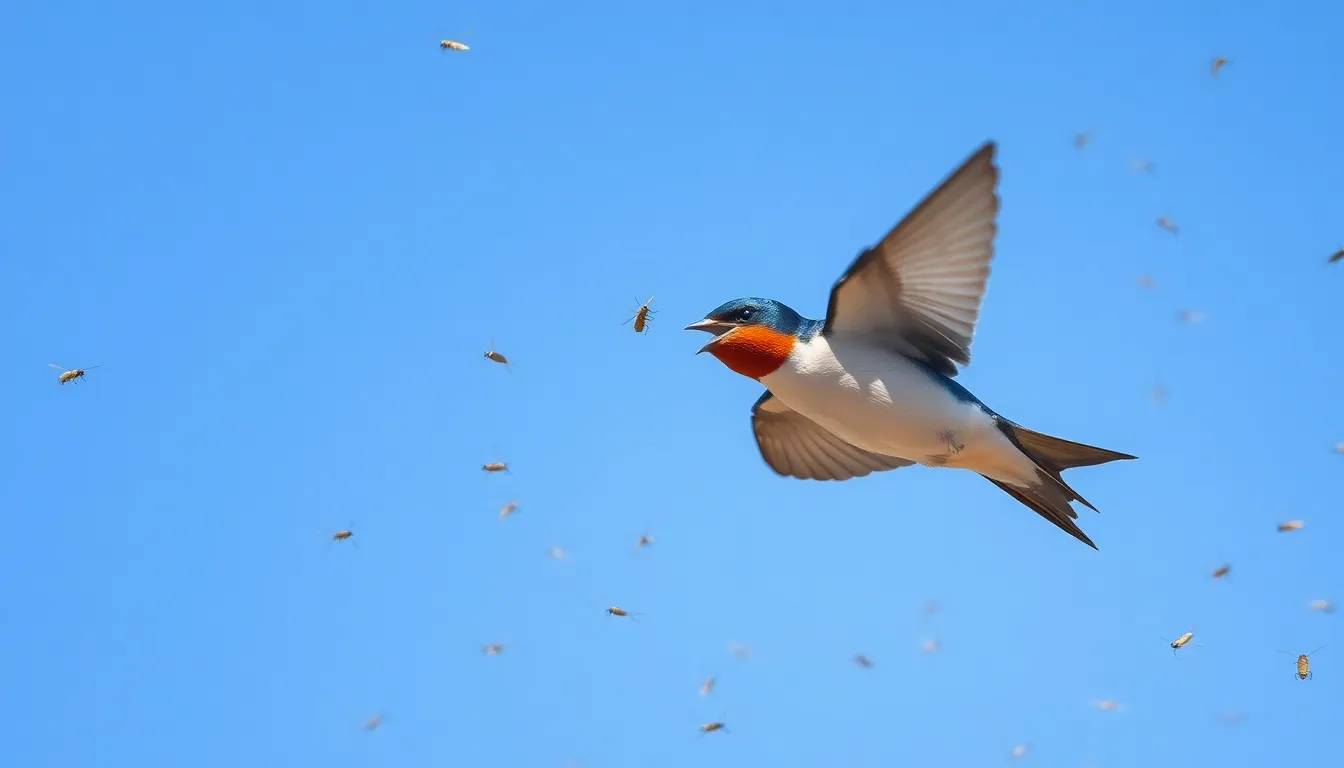
Swallows sustain themselves exclusively on aerial insects that they capture during flight using remarkable hunting techniques. We observe these birds consuming between 850 to 1,000 insects daily, with breeding adults increasing their intake to support growing chicks. Flying ants, flies, mosquitoes, beetles, moths, and winged termites comprise the bulk of their dietary preferences.
Hunting behavior demonstrates extraordinary precision as swallows execute aerial maneuvers to intercept prey mid-flight. Their wide gapes enable efficient capture of multiple insects during single hunting passes through insect swarms. Peak feeding activity occurs during dawn and dusk hours when flying insect populations reach maximum density levels.
Primary prey species include:
- Flying ants – captured during nuptial flights and swarming events
- Mosquitoes – hunted extensively over water bodies and wetland areas
- Flies – targeted in agricultural zones and livestock facilities
- Small beetles – intercepted during their dispersal flights
- Moths – pursued during evening hunting sessions
- Winged termites – consumed opportunistically during emergence events
Seasonal variations affect swallow feeding patterns significantly as insect availability fluctuates throughout the year. Spring migration coincides with emerging insect populations, while autumn feeding intensifies before long-distance journeys. Cold weather forces temporary dietary adjustments as swallows concentrate hunting efforts in sheltered microclimates where insects remain active.
Foraging territories extend 2 to 5 miles from nesting sites depending on prey abundance and competition levels. Swallows adapt their hunting altitudes from ground level to 200 feet based on atmospheric conditions and insect distribution patterns. Weather systems influence feeding success rates, with high-pressure conditions producing optimal hunting environments.
Parent swallows increase their capture rates to 15 insects per minute during chick-rearing periods, making 200 to 300 feeding trips daily to satisfy brood demands. Protein-rich prey selection becomes critical during nestling development phases when growing birds require concentrated nutrition sources for rapid growth.
Human-modified landscapes create abundant feeding opportunities through agricultural pest concentrations and artificial lighting that attracts nocturnal insects. Urban swallows exploit these resources while maintaining their specialized aerial hunting techniques across diverse environmental conditions.
Migration Patterns and Seasonal Behavior

Swallow bird populations undertake remarkable journeys spanning thousands of miles twice annually. Barn Swallows travel approximately 6,000 miles from North American breeding grounds to South American wintering territories. Tree Swallows migrate distances ranging from 2,000 to 4,000 miles depending on their breeding locations. Cliff Swallows cover similar distances while maintaining their colonial social structures throughout migration periods.
Navigation systems employed by migrating swallows combine multiple environmental cues for precise route finding. Celestial navigation using sun positions guides daytime travel while star patterns direct nighttime flights. Magnetic field detection through specialized cells in their beaks provides additional directional information. Geographic landmarks such as coastlines and mountain ranges serve as visual reference points during extended journeys.
Seasonal timing triggers migration events through exact environmental and biological factors. Daylight duration changes signal preparation for departure typically occurring between late August and early September. Food availability decreases prompt migration initiation as flying insects become less abundant. Temperature drops below optimal foraging thresholds accelerate departure schedules for northern populations.
Pre-migration behaviors demonstrate sophisticated preparation strategies among swallow species. Energy storage increases dramatically during late summer months as birds consume up to 1,200 insects daily. Molt patterns complete before departure ensuring optimal flight feathers for long-distance travel. Social gathering occurs at communal roost sites where thousands of individuals aggregate before beginning migration.
| Migration Data | Barn Swallow | Tree Swallow | Cliff Swallow |
|---|---|---|---|
| Distance Traveled | 6,000 miles | 2,000-4,000 miles | 3,000-5,000 miles |
| Departure Time | Late August | Early September | Mid August |
| Daily Flying Hours | 8-12 hours | 6-10 hours | 7-11 hours |
| Altitude Range | 500-3,000 feet | 300-2,500 feet | 400-2,800 feet |
Breeding season behaviors establish territorial boundaries and nesting site selection criteria. Males arrive at breeding territories 3 to 7 days before females to secure optimal locations. Courtship displays include aerial acrobatics demonstrating flight capabilities to potential mates. Nest construction begins immediately following pair formation using species exact materials and architectural designs.
Reproductive timing aligns with peak insect availability during spring and early summer months. First clutches typically contain 3 to 5 eggs with incubation periods lasting 12 to 16 days. Double brooding occurs in southern populations where extended warm seasons support additional reproductive attempts. Fledgling periods range from 18 to 24 days depending on species and environmental conditions.
Post-breeding aggregation patterns prepare populations for upcoming migration cycles. Family groups merge into larger flocks during late summer months creating impressive aerial displays. Roosting sites accommodate thousands of individuals in reed beds marshes and agricultural areas. Feeding intensity peaks during this period as adults and juveniles build essential fat reserves for migration journeys.
Wintering behaviors contrast significantly with breeding season activities and territorial patterns. Social structures become more cooperative as competition for resources decreases in tropical wintering grounds. Foraging territories expand allowing mixed species flocks to form temporary feeding associations. Molt schedules complete during winter months preparing birds for upcoming breeding seasons and return migration flights.
Nesting and Reproduction
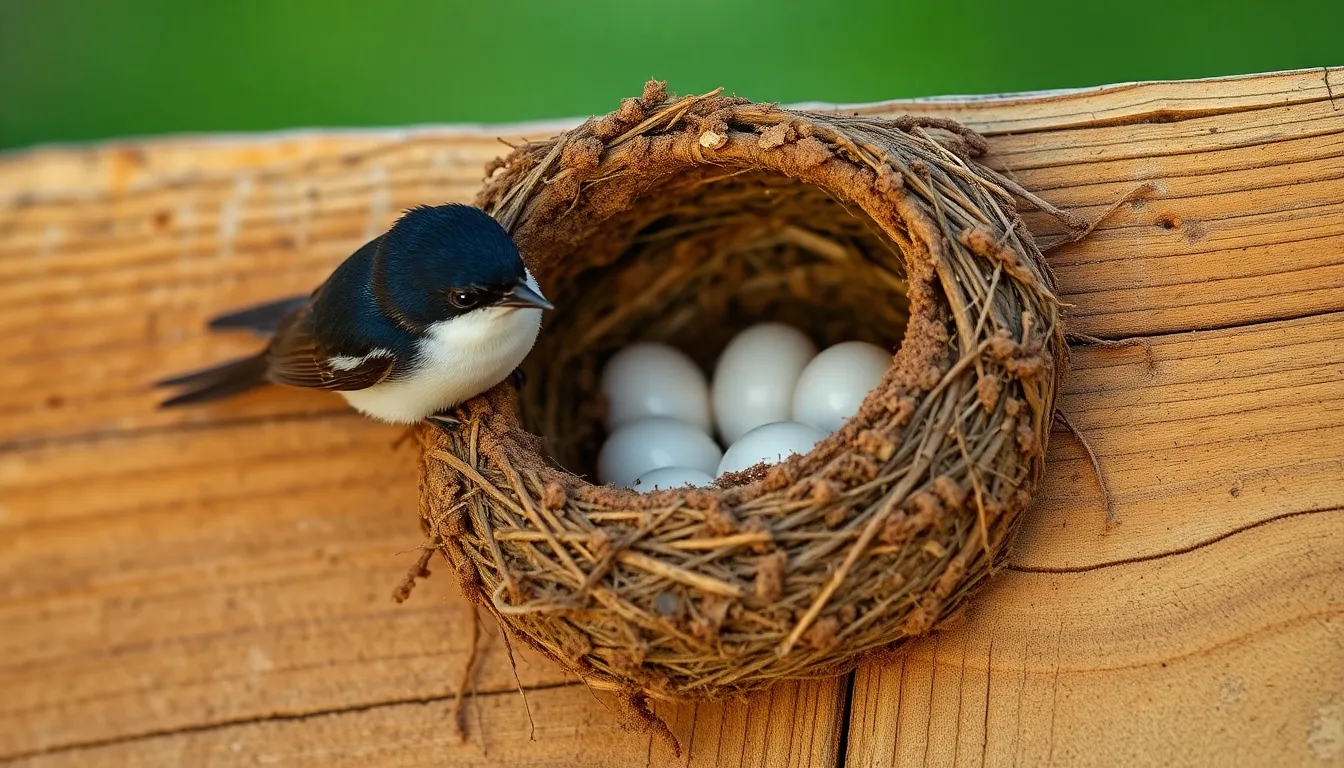
Swallows display remarkable reproductive strategies that align precisely with seasonal insect abundance. Their nesting behaviors showcase sophisticated construction techniques adapted to diverse environments worldwide.
Nest Construction
Swallows demonstrate exceptional architectural skills when building their distinctive nests using mud, plant materials, and saliva. Barn Swallows create cup-shaped structures on vertical surfaces such as barn rafters, bridge supports, and building eaves, gathering mud pellets from puddles and stream edges to form the foundation. Tree Swallows use natural cavities in dead trees, nest boxes, and cliff crevices, lining their chosen spaces with soft materials including feathers, grass, and moss.
Cliff Swallows construct gourd-shaped mud nests attached to vertical rock faces and building exteriors, creating colonies containing hundreds of individual nests clustered together. Construction typically requires 6 to 14 days depending on weather conditions and material availability. Bank Swallows excavate horizontal tunnels extending 2 to 3 feet into sandy banks, riverbanks, and quarry walls, creating chamber nests at tunnel ends.
Nest site selection prioritizes protection from predators and weather while maintaining proximity to abundant insect populations. Pairs often return to successful nesting locations from previous seasons, with some sites used continuously for multiple generations. Social species like Cliff Swallows benefit from communal nesting through enhanced predator detection and shared construction materials.
Breeding Season and Offspring
Breeding season timing corresponds directly with peak insect emergence patterns across different geographic regions. North American swallows typically initiate breeding between April and June, while Southern Hemisphere species breed during October through January. Males establish territories through aerial displays, singing, and aggressive interactions with competing males.
Courtship rituals include synchronized flight patterns, nest site presentations, and feeding demonstrations where males offer captured insects to potential mates. Females lay clutches containing 3 to 6 glossy white or speckled eggs, with incubation periods lasting 12 to 16 days depending on species and environmental conditions.
| Swallow Species | Clutch Size | Incubation Period | Fledging Time |
|---|---|---|---|
| Barn Swallow | 3-5 eggs | 13-15 days | 18-23 days |
| Tree Swallow | 4-6 eggs | 12-14 days | 16-24 days |
| Cliff Swallow | 3-4 eggs | 14-16 days | 21-26 days |
Both parents participate in incubation duties and chick feeding responsibilities, making 150 to 300 feeding trips daily during peak nestling periods. Young swallows fledge after 16 to 26 days but continue receiving parental care for additional weeks while developing flight proficiency. Many species produce two broods annually when environmental conditions support extended breeding seasons, maximizing reproductive success during favorable periods.
Swallow Birds and Human Interaction
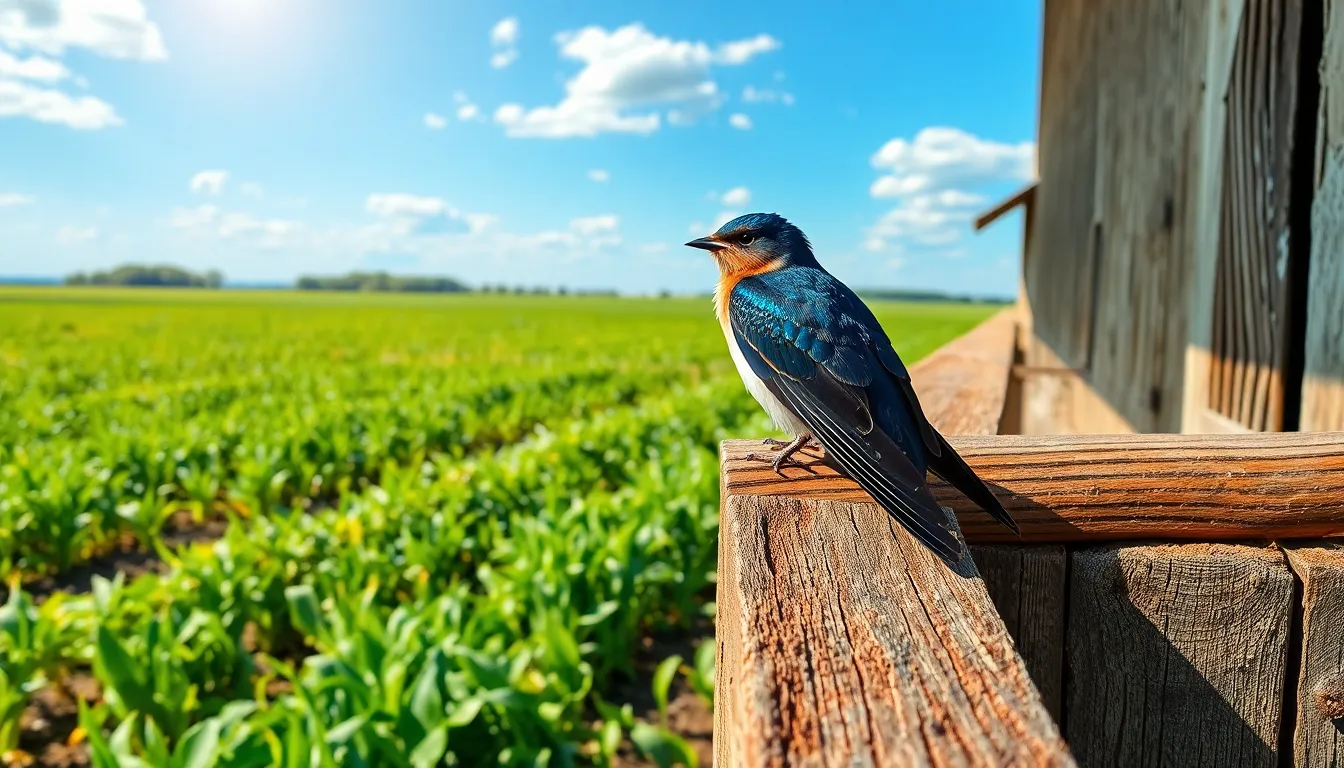
Swallow birds maintain complex relationships with human communities that span agricultural benefits and deep cultural connections. These aerial insectivores create positive impacts on farming operations while inspiring traditions across diverse civilizations.
Benefits to Agriculture
Swallow populations provide substantial pest control services to agricultural operations through their voracious appetite for flying insects. A single swallow consumes between 850 to 1,000 insects daily, targeting agricultural pests like mosquitoes, flies, aphids, and flying ants that damage crops and livestock.
Farmers observe dramatic reductions in pest populations when swallow colonies establish territories near agricultural fields. Barn Swallows patrol crop areas during peak insect activity periods at dawn and dusk, intercepting pests before they reach vulnerable plants. Their hunting efficiency increases during breeding season when parent birds make 150 to 200 feeding trips daily to nourish their young.
Economic benefits from swallow pest control reach important levels in agricultural regions. Studies document pest reduction rates of 60 to 80% in areas with active swallow populations compared to locations without these natural predators. Grape vineyards, cattle ranches, and vegetable farms report decreased pesticide usage when swallows maintain hunting territories nearby.
Organic farming operations particularly value swallow colonies as biological pest management systems. Tree Swallows consume massive quantities of agricultural pests without chemical interventions, supporting sustainable farming practices. Their presence indicates healthy ecosystems that support diverse insect populations while maintaining natural predator-prey balance.
Cultural Significance
Swallow symbolism permeates human cultures worldwide, representing concepts of renewal, hope, and faithful return. European folklore associates swallow arrivals with spring’s beginning and agricultural seasons, creating deep connections between these birds and human calendar systems.
Maritime traditions incorporate swallow imagery as symbols of safe voyages and homecoming. Sailors historically tattooed swallow designs to commemorate nautical miles traveled, with each bird representing 5,000 miles covered during ocean journeys. Their return migration patterns inspired confidence in navigation and successful voyage completion.
Religious traditions across Christianity, Islam, and Buddhism feature swallow symbolism in sacred texts and artistic representations. Christian iconography depicts swallows as symbols of resurrection and spiritual rebirth, while Islamic culture views their return as divine blessings. Buddhist teachings reference swallow migration patterns as examples of natural cycles and impermanence.
Modern conservation movements use swallow species as flagship birds for habitat preservation campaigns. Their declining populations in urbanized areas mobilize community efforts to create nesting sites and maintain insect-rich environments. Citizen science projects engage thousands of volunteers in monitoring swallow colonies and migration timing across North America and Europe.
Architectural traditions incorporate swallow-friendly design elements in barn construction, bridge engineering, and residential planning. Traditional European barns include specialized openings and ledges that accommodate swallow nesting requirements, demonstrating centuries of coexistence between humans and these aerial specialists.
Conservation Status and Threats
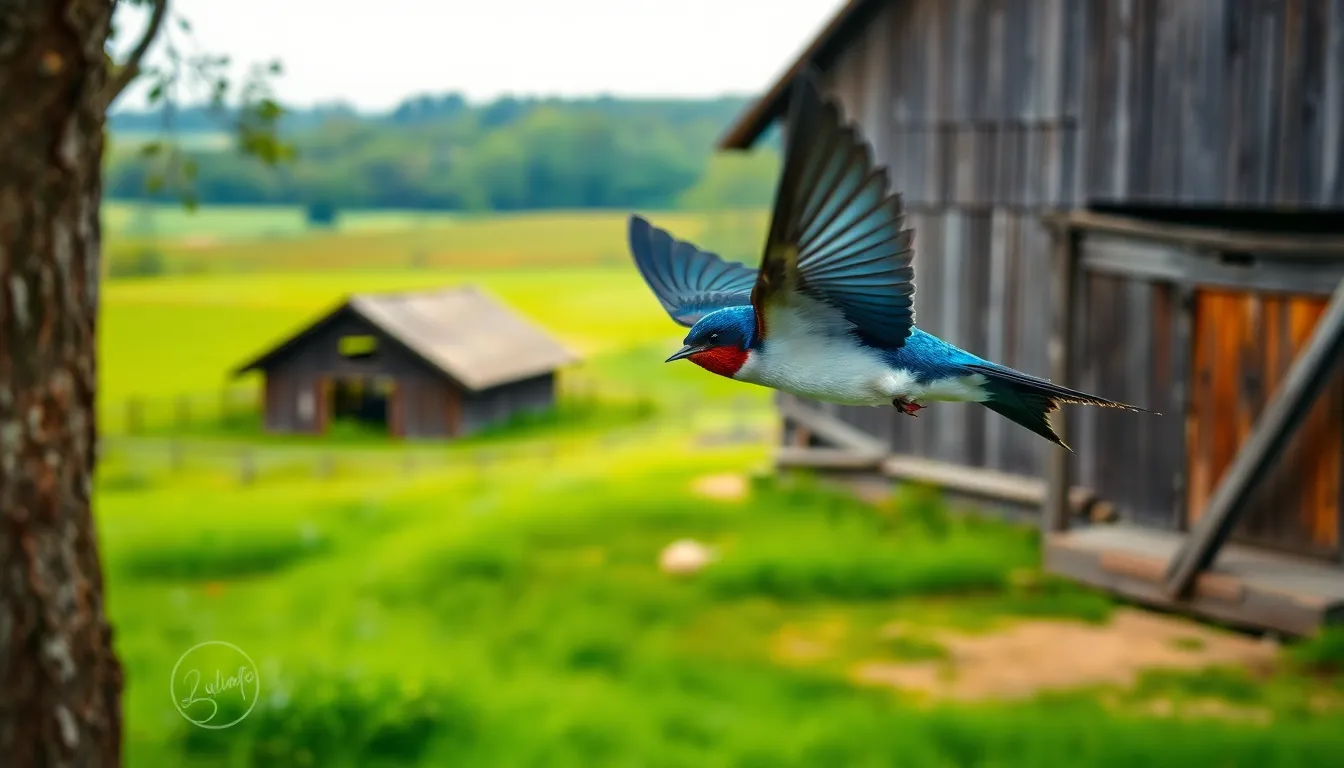
Swallow populations face mounting pressures across their global range as habitat destruction accelerates worldwide. Agricultural intensification eliminates the diverse landscapes these aerial hunters require for nesting and foraging. Pesticide use reduces insect populations by 70% in treated areas according to recent ecological studies, directly impacting swallow food sources.
Climate change disrupts the precise timing swallows depend upon for migration and breeding cycles. Temperature shifts alter insect emergence patterns, creating mismatches between peak food availability and chick-rearing periods. Extreme weather events during migration routes cause important mortality rates among long-distance travelers like Barn Swallows.
Urban development removes traditional nesting sites at alarming rates across North America and Europe. Building renovations and modern construction practices eliminate eaves, barns, and other structures that support swallow colonies. Bridge modifications destroy established Cliff Swallow communities that have occupied the same locations for decades.
Current Population Trends
| Species | Population Status | Decline Rate | Primary Threats |
|---|---|---|---|
| Barn Swallow | Declining | 38% since 1970 | Habitat loss, pesticides |
| Tree Swallow | Stable | 5% decline | Nest box competition |
| Cliff Swallow | Variable | Regional declines | Development, weather |
| Bank Swallow | Declining | 50% since 1970 | Erosion control, mining |
Exact Conservation Challenges
Bank Swallows experience the steepest population declines among North American species due to riverbank stabilization projects. Erosion control measures eliminate the sandy cliffs these colonial nesters require for excavating burrows. Mining operations destroy breeding colonies during the critical nesting season when adults cannot relocate.
Purple Martins depend entirely on human-provided nest boxes in eastern North America, making them vulnerable to housing shortages. Competition from European Starlings and House Sparrows reduces available cavities by 60% in urban areas. Landlord dedication determines colony success rates, creating conservation dependence on individual commitment.
International Protection Efforts
Migratory bird treaties protect swallows across international boundaries, establishing legal frameworks for species conservation. The Migratory Bird Treaty Act prohibits nest destruction during breeding seasons, though enforcement remains inconsistent. International cooperation between breeding and wintering grounds becomes essential for long-distance migrants.
Habitat restoration projects focus on creating insect-rich environments that support swallow populations throughout their annual cycles. Organic farming initiatives reduce pesticide impacts while maintaining productive agricultural landscapes. Wetland conservation provides crucial foraging areas during migration stopovers.
Regional Conservation Success Stories
European House Martin populations have stabilized through targeted nest box programs in urban areas. Artificial nest structures compensate for modern building designs that lack suitable nesting ledges. Community involvement in nest box maintenance creates sustainable conservation partnerships.
Tree Swallow populations benefit from extensive nest box networks managed by citizen scientists across North America. Bluebird trail programs inadvertently support Tree Swallow recovery by providing alternative nesting opportunities. Monitoring data from these networks informs adaptive management strategies.
Conservation efforts increasingly recognize swallows as indicator species for network health, linking their population trends to broader environmental quality assessments.
Conclusion
When we observe these remarkable aerial acrobats in our skies we’re witnessing millions of years of evolutionary perfection. These birds continue to inspire us with their resilience and adaptability while facing modern challenges that threaten their future.
Our collective efforts in conservation and habitat preservation will determine whether future generations can experience the wonder of swallow migrations. By supporting sustainable farming practices and creating nest-friendly environments we can ensure these incredible birds remain part of our natural heritage.
The next time we see swallows dancing through the air we’ll remember that we’re not just watching birds – we’re observing nature’s most skilled aviators whose survival depends on our commitment to protecting their industry.
Frequently Asked Questions
What are swallows and how many species exist?
Swallows are passerine birds belonging to the Hirundinidae family, comprising over 90 species worldwide. They’re known for their streamlined bodies, long pointed wings, and exceptional flying abilities. These aerial hunters are found on every continent except Antarctica, with familiar North American species including Barn Swallows, Tree Swallows, and Cliff Swallows.
What do swallows look like and how big are they?
Most swallows measure 4-8 inches in length with wingspans of 10-17 inches. They have torpedo-shaped bodies, deeply forked tails, and short wide beaks designed for catching insects. Their coloration typically features metallic blue or green upperparts with lighter underparts, and some species show sexual dimorphism during breeding seasons.
What do swallows eat and how much do they consume daily?
Swallows are exclusively aerial insectivores, consuming 850-1,000 insects daily during flight. Their diet includes flying ants, mosquitoes, flies, small beetles, moths, and winged termites. They hunt with extraordinary precision, particularly at dawn and dusk, and parent swallows significantly increase their capture rates during chick-rearing periods.
How far do swallows migrate and how do they navigate?
Swallows undertake impressive migrations spanning thousands of miles twice annually. Barn Swallows travel approximately 6,000 miles from North America to South America, while Tree Swallows migrate 2,000-4,000 miles. They navigate using environmental cues, celestial navigation, and magnetic field detection for precise route finding.
Where do swallows build their nests?
Swallows use mud, plant materials, and saliva to construct nests in various locations. Barn Swallows build cup-shaped nests on vertical surfaces like building eaves, Tree Swallows utilize natural cavities or nest boxes, and Cliff Swallows create gourd-shaped colonial nests. They prioritize protection from predators and proximity to insect populations.
How do swallows benefit humans and agriculture?
Swallows provide substantial agricultural benefits through natural pest control, consuming large quantities of harmful insects and reducing pesticide needs. In farming areas, they achieve significant pest reduction rates, benefiting crops and livestock. Culturally, swallows symbolize renewal and hope across various civilizations and inspire folklore traditions.
What threats do swallows face and what is their conservation status?
Swallows face habitat destruction, agricultural intensification, and pesticide use, with studies showing 70% insect population reductions in treated areas. Climate change disrupts migration and breeding cycles, while urban development threatens nesting sites. Several species like Barn Swallows and Bank Swallows show declining population trends.
How can people help conserve swallow populations?
Conservation efforts include habitat restoration projects, organic farming initiatives, and nest box programs. International migratory bird treaties provide legal protection, though enforcement varies. Communities can help by maintaining swallow-friendly architecture, avoiding pesticides, and participating in citizen science monitoring programs to track population trends.

